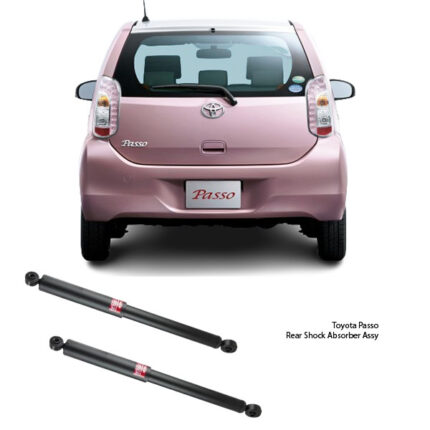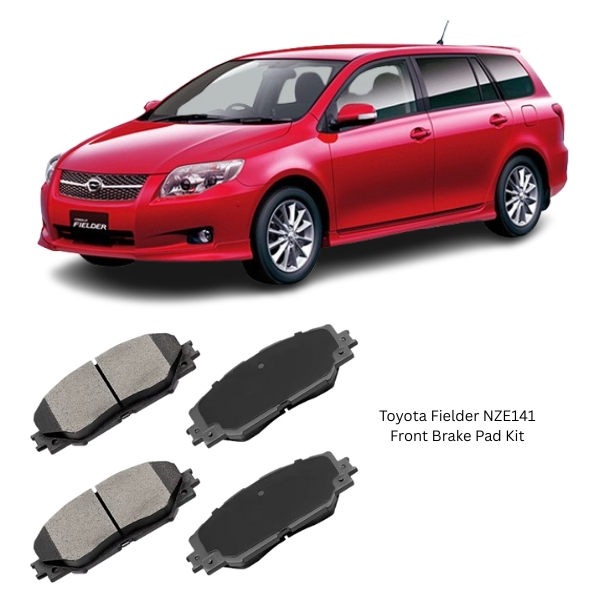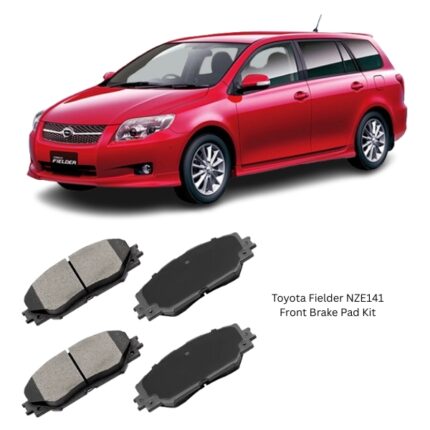Get Toyota Fielder NZE141 Front Brake Pad Kit D2274 in Kenya
The front brake pad kit is a vital component of a vehicle’s braking system, designed to deliver consistent, reliable, and safe stopping performance under various driving conditions. As part of the disc brake system, front brake pads create the necessary friction against the brake rotor to slow down or stop the vehicle effectively. Due to their crucial role in vehicle safety, brake pads must be manufactured with precision, using high-quality materials, and must meet strict industry standards for performance, durability, and heat resistance.
This product description explores the function, construction, installation relevance, performance characteristics, warning signs of wear, and maintenance tips related to the front brake pad kit.
Purpose and Function of Front Brake Pads
Front brake pads are friction elements that work in tandem with the brake rotors (discs) to convert kinetic energy into thermal energy during braking. When the driver presses the brake pedal, hydraulic pressure forces the brake caliper pistons to press the brake pads against the spinning rotors. The resulting friction slows the wheel rotation and eventually brings the vehicle to a stop.
Since most vehicles are front-heavy and experience more weight transfer to the front wheels during braking, the front brake pads are typically subjected to more stress and wear than the rear. This makes their condition and performance critical to safe driving.
Components Included in a Brake Pad Kit
A typical front brake pad kit includes the following components:
-
Brake Pads (Left and Right Pair): The main friction elements with backing plates and friction material.
-
Anti-Rattle Clips or Shim Kits: Help reduce vibration, noise, and brake chatter.
-
Wear Sensors (if applicable): Provide early warnings when pads are worn.
-
Grease or Lubricant Packs: Applied to contact points to reduce noise and enhance fitment.
-
Installation Hardware: May include caliper pin boots, clips, and retaining pins depending on the vehicle design.
These components are precision-engineered to work together, ensuring optimal braking performance and longevity.
Brake Pad Material Types
Brake pads are manufactured using various friction materials, each with its own performance characteristics:
-
Semi-Metallic: Composed of metals like steel, copper, and iron mixed with friction modifiers. They offer excellent braking power and heat resistance, commonly used in a wide range of vehicles.
-
Ceramic: Made from ceramic fibers and bonding agents, ceramic brake pads provide quieter operation, produce less dust, and offer stable performance over a broad temperature range.
-
Organic (Non-Asbestos Organic – NAO): Made from natural fibers, glass, rubber, and resins. These pads are softer, quieter, and produce less dust but wear out faster and are less effective under high-stress braking.
-
Low-Metallic NAO: A hybrid of organic materials with small amounts of metal added for better heat dissipation and braking performance.
Each type serves specific driving needs, such as high-performance, daily commuting, or heavy-duty applications.
Key Performance Characteristics
A well-designed front brake pad kit offers the following performance advantages:
-
Consistent Friction Performance: Maintains effective stopping power across different temperatures and road conditions.
-
Noise Reduction: Advanced shim technology and anti-rattle clips help minimize brake noise and vibration.
-
Thermal Stability: Resistant to brake fade caused by high temperatures during prolonged braking.
-
Low Dust Formulation: Reduces brake dust accumulation on wheels, keeping them cleaner.
-
Rotor Compatibility: Engineered to provide even rotor wear and avoid scoring or grooving.
-
Long Wear Life: Designed for durability under normal and severe driving conditions.
These qualities contribute to safe, smooth, and confident braking over the life of the pads.
Installation and Fitment
The front brake pad kit is designed to match the specifications of the original equipment (OE) system. Accurate fitment is crucial for achieving optimal performance and safety. Factors such as pad thickness, backing plate dimensions, shim placement, and mounting clip positions are all precisely manufactured to ensure perfect alignment with the brake caliper and rotor.
When replacing front brake pads, it is essential to inspect the brake rotors for wear or damage. Rotors that are warped, grooved, or below minimum thickness should be replaced or resurfaced to ensure even contact and proper braking function.
It is also recommended to install brake pads in pairs (left and right) to maintain balance and avoid uneven braking.
Signs of Worn or Failing Front Brake Pads
Regular inspection of brake pads is important to identify signs of wear or deterioration. Common indicators that front brake pads need replacement include:
-
Squealing or Screeching Noise: High-pitched noise when braking may indicate worn pads or embedded debris.
-
Grinding Sound: Metal-on-metal contact due to pads wearing down to the backing plate.
-
Increased Stopping Distance: A noticeable decline in braking efficiency.
-
Vibration or Pulsation: Uneven pad wear or rotor issues causing inconsistent braking feedback.
-
Brake Warning Light: Some systems include sensors that alert the driver when pads are worn.
-
Visual Inspection: If the pad thickness is less than 3 mm, replacement is recommended.
Ignoring worn brake pads can lead to rotor damage, increased stopping distances, and potential brake system failure.
Maintenance Tips for Brake Pad Longevity
Proper maintenance helps extend the lifespan of front brake pads and ensures consistent performance:
-
Avoid Hard Braking: Gentle braking extends pad life and reduces rotor stress.
-
Flush Brake Fluid Periodically: Contaminated fluid can damage calipers and affect pad performance.
-
Inspect Brake Components Regularly: Check pads, rotors, calipers, and hardware for wear or corrosion.
-
Use Brake Grease on Contact Points: Reduces noise and allows for smoother operation.
-
Ensure Correct Installation: Pads must be properly aligned with hardware and shims for effective performance.
Regular brake system inspections should be part of scheduled vehicle maintenance, particularly for vehicles driven in urban traffic or under heavy load.
Packaging and Storage
Front brake pad kits are securely packaged to prevent damage to the pads or accessories during transit and storage. The pads are typically sealed in corrosion-resistant materials and organized with hardware components for quick identification and installation. Kits should be stored in a dry, cool environment away from moisture or extreme temperatures.
Follow us on Facebook for more parts.




